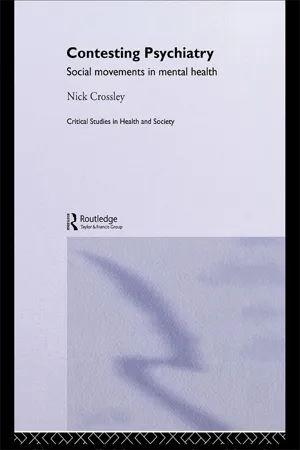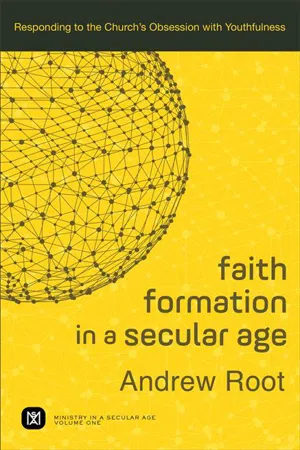History
Counterculture of the 1960s
The counterculture of the 1960s was a social and cultural movement that emerged in response to the conservative norms of the time. It was characterized by a rejection of traditional values, experimentation with alternative lifestyles, and a focus on social and political activism. The counterculture encompassed various aspects such as music, fashion, art, and political ideologies, and had a lasting impact on society.
Written by Perlego with AI-assistance
Related key terms
5 Key excerpts on "Counterculture of the 1960s"
- eBook - ePub
Contesting Psychiatry
Social Movements in Mental Health
- Nick Crossley(Author)
- 2006(Publication Date)
- Routledge(Publisher)
The ‘well-adjusted’ individual whom psychiatry takes as an ideal is no less false, on account of the crazy world to which they are well adjusted. Indeed they are more false. The new left was by no means the only audience or public for such claims. This was the 1960s and Britain, like most other Western democracies, was in the early stages of a wave of contention. A culture of protest was spreading, particularly on university campuses, and both the number of political groups in society and their respective levels of activity were increasing. In addition, what became known as the counter-culture was beginning to take shape; a culture of opposition to the status quo and of experimentation with new and novel practices that went well beyond the politics of the new left. There has been much nostalgic mythmaking about the ‘counter-culture’. There is good sociological evidence of strong changes in both the attitudes and practices of young people through the course of the 1960s, however. The work of Musgrove (1964, 1974) is an interesting case in point. Having conducted a survey of youth attitudes and activities in the early 1960s, Musgrove found himself publishing his results at a point where those very attitudes and activities seemed to be undergoing a profound transformation (Musgrove 1964). Consequently he set about replicating his own study almost immediately, and what he found offered strong support for the idea of a counter-cultural wave of change (Musgrove 1974). Ideas and more particularly the practices of everyday life for young people had changed markedly. They were stepping outside of the norms and roles previously expected of them, collectively effecting change through the excited and experimental interactions that Durkheim (1915) dubs ‘collective effervescence’. 5 Musgrove’s study dates the key period of change between 1964 and 1969. This makes Laing an ‘early riser’ and opinion leader of the counter-cultural current - eBook - ePub
- Terry H. Anderson(Author)
- 2017(Publication Date)
- Routledge(Publisher)
Time called a “youthquake” shaking the moral foundations of America. This motley crew was composed of activists, some students and emerging feminists, and especially hippies. Although never organized, they created a great vocal minority that promoted liberation, challenged the silent majority, and confronted and shocked mainstream culture—the counterculture.The counterculture had been flourishing since the 1967 Summer of Love, even though after that event the culture declared war: “Trouble in Hippieland” wrote Newsweek , claiming that most flower children were “seriously disturbed youngsters” or “overprivileged products of the American dream.” In 1968 Reader’s Digest concluded for its 28 million readers that “Murder, rape, disease, suicide—the dark side of the hippie moon has become increasingly visible,” and the next year a journalist summed up the older generations’ knowledge of these cultural rebels when he gave his peers advice on how to spot one: “Well, hippies look like hippies.”The Establishment’s interpretation of the counterculture had been written, and it became accepted creed. By the end of the decade an opinion poll asked citizens to identify the most harmful groups in the nation, and they listed “Communists, prostitutes, and hippies.” Later historians and pundits of the era usually avoided writing about the hippies after discussing the Summer of Love, or they based their books on mainstream press sources as they wrote for the next generation of college students. In one popular text, a historian described hippies as “countless thousands of disturbed youngsters” whose experiences generally were “stupid, pointless, and self-defeating.” Ever since, hippie has come to symbolize something negative, disliked, rather like commie - eBook - ePub
Faith Formation in a Secular Age : Volume 1 (Ministry in a Secular Age)
Responding to the Church's Obsession with Youthfulness
- (Author)
- 2017(Publication Date)
- Baker Academic(Publisher)
9 . King made a call not to overthrow the system but to truly connect the ideals of the system with the actualities. King wisely called the system to provide what it promised people of color—instead of giving them a check with insufficient funds. King was calling a nation to rethink its normative commitment, not to live without norms so all could be free to be authentically their individual selves.10 . Anderson writes,Many commentators have discussed the origins of the counterculture. Most have mentioned that throughout American history there have been those who do not fit into the mainstream, misfits. In earlier times they might have been roamers, drifters, mountain men, or Utopians at communities such as Oneida, New Harmony, or various Shaker or Hutterite settlements. As America urbanized they clustered in cities—bohemians after the First World War, student radicals during the Depression, beatniks during the cold war. Since future hippies were being raised during the postwar era, some were influenced by contemporary intellectuals and poets. Paul Goodman discussed Growing Up Absurd , William Whyte challenged students to “fight The Organization,” and beat poets ridiculed society and urged readers to get “On the Road.” “We gotta go and never stop going till we get there,” said one of Jack Kerouac’s characters, and in Desolation Angels the author spoke of “a ‘rucksack revolution’ with all over America ‘millions of Dharma bums’ going up to the hills to meditate and ignore society.” Some writers emphasized that the counterculture was a response to technology. . . Others viewed the growth of hippiedom as a result of a massive sixties generation that came of age. More kids meant more dissension from social norms. Throw in the Beatles, and presto: The Summer of Love. (Movement and the Sixties - eBook - ePub
Singing Poets
Literature and Popular Music in France and Greece (1945-1975)
- Dimitris Papanikolaou(Author)
- 2017(Publication Date)
- Routledge(Publisher)
For Roszak, counterculture, a ‘mystic revolution’ that traces its beginnings from the beatniks, is the cultural expression through which ‘the alienated young are giving shape to something that looks like the saving vision of our endangered civilization' (Roszak 1995: 1, 124–25). Even though counterculture has often been confused with subculture, there is also a long tradition of theorists who rely on a clear distinction between the two terms. For Dick Hebdige, a subculture consists of ‘the expressive forms and rituals of those subordinate groups [...] who are alternately dismissed, denounced and canonized; treated at different times as threats to public order and as harmless buffoons’ (Hebdige 1988: 2, my emphasis). Hebdige and his colleagues from the University of Birmingham Centre for Contemporary Cultural Studies (CCCS) saw subcultures as characteristic of working-class groups, ‘clearly articulated, collective structures — often “near-” or “quasi-”gangs’ (Hall 1976: 60). On the other hand, countercultural trends of the 1960s, like the mods, the hippies, and ‘the alternative institutions of the Underground’ were largely characterized as ‘middle-class... diffuse, less group-centred, more individualized [...]; [they] precipitate, typically, not tight sub-cultures but a diffuse counterculture milieu ’ (ibid.). With the benefit of hindsight, we now know that such a class-based distinction is very problematic and potentially invalid. Most of the ‘pure working class features’ that theorists acknowledged in the subcultures they analysed seem to have been performatively inscribed by the analysis rather than existing independently of it - eBook - ePub
Uprising at Bowling Green
How the Quiet Fifties Became the Political Sixties
- Norbert Wiley, Joseph B Perry Jr, Arthur G. Neal(Authors)
- 2015(Publication Date)
- Routledge(Publisher)
Chapter 8 ). The first part of this chapter will be a description of the sixties, showing how the BG case fits into the pattern. The second part will be a causal section exploring the question of what caused the sixties.DESCRIPTION OF THE SIXTIESFigure 3.1 gives a timeline of the sixties, locating several of the main events and turning points. This is not meant to be a complete picture of the decade. We list just enough points to contextualize the Bowling Green story. We abbreviate names to squeeze all nine entries onto a single line.Figure 3.1 Timeline of Sixties Protest MovementFor some purposes, the fifties were a long decade and the sixties started “late.” But for our purposes in this chapter, the political sixties were a long decade, positioned between two events. The first, which initiated the sixties, was the African American civil rights movement. This began in earnest in December 1955 with the boycott of the segregated Montgomery, Alabama, bus system, a movement led by Martin Luther King Jr. At the other end, the point which concluded the sixties, which were already winding down, was the recession of 1973–1974 and more importantly the “stagflation” which it initiated. This was an unprecedented combination of high unemployment and high inflation, a combination for which the American government had no effective measures.The American economy had been enjoying the long postwar expansion from the late fifties until 1973. Perhaps one of the reasons the sixties could be a student protest decade was the availability of well-paying jobs and discretionary income. In fact, the prosperity years coincide almost exactly with the enlarged decade of the sixties. Most students did not have to worry much about income during their student years or, as they probably thought, about a job afterward. All that changed with stagflation. We well remember students in the early seventies saying resignedly, “The protests are over; it’s time to pay the bills.”The fifties were a politically quiet decade for the most part. Left-of-center political expression was intimidated by anti-Communism and McCarthyism. The hearings of the House Un-American Activities Committee (HUAC) and the aggressiveness of the FBI scared both Communists and ordinary liberals. No doubt the fact that the Russians got the atom bomb in 1949 and the Korean War began in 1950 added to the fear of Communists. The ordinary politics of interest groups, in which the forces of big business and their allies were constantly trying to suppress liberalism, was also central to the apolitical nature of this decade. In fact, ordinary politics was probably a factor in why there was so much anti-Communism, particularly when Communism was so weak in American society. To some extent, anti-Communism was an excuse for the forces of the Right to intimidate the forces of the Left, including ordinary liberalism.
Learn about this page
Index pages curate the most relevant extracts from our library of academic textbooks. They’ve been created using an in-house natural language model (NLM), each adding context and meaning to key research topics.




